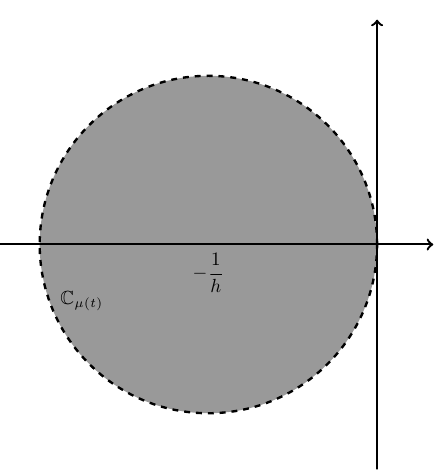Difference between revisions of "Multiples of integers"
From timescalewiki
| Line 26: | Line 26: | ||
\end{array}$ | \end{array}$ | ||
|- | |- | ||
| − | |[[Hilger circle | + | |[[Hilger circle]]: |
| − | | [[File:Hilgercircle%2CT%3DhZ.png|250px | + | | [[File:Hilgercircle%2CT%3DhZ.png|250px]] |
|- | |- | ||
|[[Gamma function]]: | |[[Gamma function]]: | ||
| $\Gamma_{h\mathbb{Z}}(t;s)=h\displaystyle\sum_{k=0}^{\infty} \left( \displaystyle\prod_{j=s}^{k-1} \dfrac{j+x}{j+1} \right) \dfrac{1}{(1+h)^{k+1}}.$ | | $\Gamma_{h\mathbb{Z}}(t;s)=h\displaystyle\sum_{k=0}^{\infty} \left( \displaystyle\prod_{j=s}^{k-1} \dfrac{j+x}{j+1} \right) \dfrac{1}{(1+h)^{k+1}}.$ | ||
|} | |} | ||
Revision as of 06:21, 19 October 2014
The set $h\mathbb{Z}=\{\ldots,-2h,-h,0,h,2h,\ldots\}$ of multiples of the integers is a time scale.
| Generic element $t\in \mathbb{T}$: | For some $n \in \mathbb{Z}, t =hn$ |
| Jump operator: | $\sigma(t)=t+h$ |
| Graininess operator: | $\mu(t)=h$ |
| $\Delta$-derivative: | $f^{\Delta}(t)=\dfrac{f(t+h)-f(t)}{h}$ |
| $\Delta$-integral: | $\displaystyle\int_s^t f(\tau) \Delta \tau = \displaystyle\sum_{k=\frac{s}{h}}^{\frac{t}{h}-1} hf(hk)$ |
| Exponential function: | $\begin{array}{ll} e_p(t,s) &= \exp \left( \displaystyle\int_{s}^{t} \dfrac{1}{\mu(\tau)} \log(1 + hp(\tau)) \Delta \tau \right) \\ &= \exp \left( \displaystyle\sum_{k=\frac{s}{h}}^{\frac{t}{h}-1} \log(1+hp(hk)) \right) \\ &= \displaystyle\prod_{k=\frac{s}{h}}^{\frac{t}{h}-1} \left( 1+hp(hk) \right) \\ \end{array}$ |
| Hilger circle: | 
|
| Gamma function: | $\Gamma_{h\mathbb{Z}}(t;s)=h\displaystyle\sum_{k=0}^{\infty} \left( \displaystyle\prod_{j=s}^{k-1} \dfrac{j+x}{j+1} \right) \dfrac{1}{(1+h)^{k+1}}.$ |